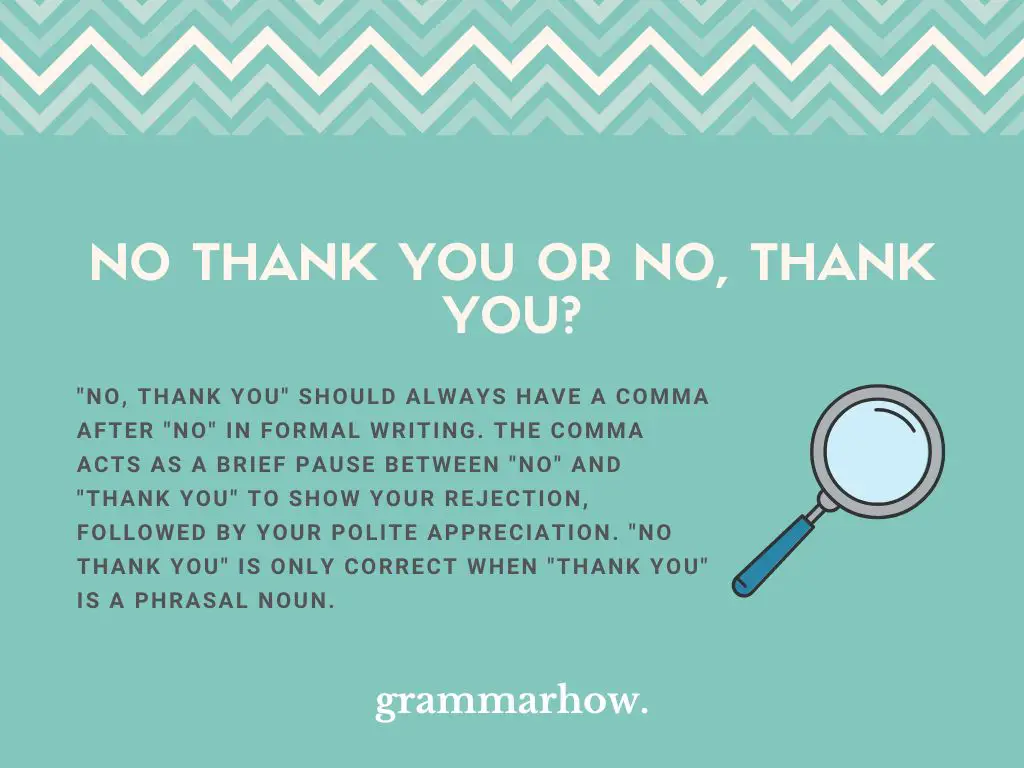Comma rules are fairly consistent when using words like “yes” and “no.” This article will explore comma rules associated with the phrase “no, thank you.” We’ll help you understand when you should (and shouldn’t) include a comma.
No Thank You or No, Thank You?
“No, thank you” should always have a comma after “no” in formal writing. The comma acts as a brief pause between “no” and “thank you” to show your rejection, followed by your polite appreciation. “No thank you” is only correct when “thank you” is a phrasal noun.

“No thank you” is also a common idiomatic expression in informal English. It’s common for people to write “no thank you” in text messages since there is less dependency on using correct grammar.
No Thank You
You can use “no thank you” without a comma in very specific circumstances. It only works when you are rejecting someone’s “thank you,” and “thank you” must be used as a phrasal noun in any sentences that include it.
Here are some examples to show you how to use “no thank you” in a sentence:
- No thank you is necessary from you. I’m happy to help you in any way.
- You need to give me no thank yous. I’m happy to do what I can here.
- No thank you required, sir! I’ll do whatever it takes to help you out.
As you can see, you do not need a comma because “thank you” acts as a phrasal noun referring to someone else saying “thank you.” “No thank you” implies that you do not require the other person to say thank you.
In most formal cases, “no thank you” is incorrect, as you can see here:
- Correct: No, thank you. I do not want to take part in this game.
- Incorrect: No thank you. I’ll see you later because I don’t want to be here.
No, Thank You
You should use “no, thank you” in every formal situation where you reject something politely. The comma is required in “no, thank you” to break up your rejection from the polite “thank you” comment. It helps to create a natural pause in the sentence.
It’s fairly common for native writers to forget about the comma, so don’t feel bad if you do as well. It’s a difficult habit to build. With practice, you should get a lot more familiar with the use of the comma after “no.”
Here are some examples to show you how to use “no, thank you” in a sentence:
- No, thank you. I don’t think it’s wise for me to take part in this sport.
- No, thank you. I appreciate the offer, but I think it’s best for us to stay away.
- No, thank you. I’m so sorry, but I don’t want to be around you when this kicks off.
- No, thank you. I get what you’re trying to say, but I don’t see how it’ll help me.
- No, thank you. There isn’t much else that I want to add to this problem.
No Thanks or No, Thanks?
“No, thanks” follows the same rules as “no, thank you.” You should include the comma in “no, thanks” when you want to reject something politely. It is correct to do this in formal English.
These examples will show you how to include the correct form:
- No, thanks. I don’t think I want to be here when she comes back.
- No, thanks. I’m not hungry right now. Maybe later.
- No, thanks. I’m sure you’ll find someone else to stand in, though.
Similar to “no thank you,” you may use “no thanks” when “thanks” is a noun referring to someone else saying “thanks.” It’s a rare situation, but it’s correct to avoid the comma like this:
- I need no thanks from you. You’ve given me so much already.
- No thanks are required. You’re my best friend.
- You need to give me no thanks. I’m not sure why you felt the need to do so.
Final Thoughts
“No, thanks” and “no, thank you” are grammatically correct. You should include the comma in all formal written situations when rejecting someone but remaining polite. “No thank you” and “no thanks” are only correct if “thanks” is a noun referring to someone else’s appreciation.

Martin holds a Master’s degree in Finance and International Business. He has six years of experience in professional communication with clients, executives, and colleagues. Furthermore, he has teaching experience from Aarhus University. Martin has been featured as an expert in communication and teaching on Forbes and Shopify. Read more about Martin here.

